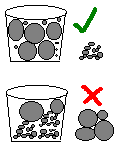
As text it reads:
Bird's eye view of life cycle
Exploration
Explore
- business domain
- technology
- process
- scope
Keep as short as possible (< 2 weeks)
Release planning - create roadmap of releases
Release planning - create roadmap of releases
- May not happen until some initial iterations
- Flesh out plan as you progress
- Deliver high risk / high value items early
- Set concrete release dates but vary features
Iterations
Production - aim is to arrive here ASAP
Planning phases
Customer needs
Implementation considerations
Implementation tasks
Estimated task list
Customer reviews effort vs. necessity
UI Design is often done an iteration ahead,
to help users & team understand what is required
to help users & team understand what is required

